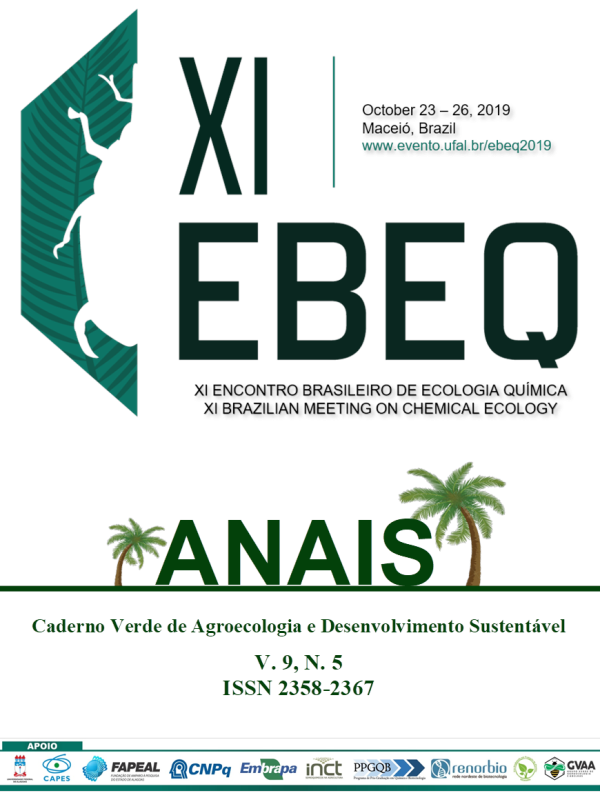COMPORTAMENTO DE OVIPOSIÇÃO DE Plodia interpunctella (LEPIDOPTERA: PYRALIDAE) COM DIFERENTES OPÇÕES DE ESCOLHA
Palavras-chave:
MARIPOSA INDIANA, GRÃOS ARMAZENADOS, CEREALResumo
P. interpunctella é uma importante praga de grãos e sementes armazenados. A maioria dos estudos são focados na utilização de inseticidas. Seu feromônio é o (Z,E)-9,12-tetradecadien-l-ol acetato, identificado em 1980. O seu comportamento é pouco estudado, principalmente a preferência por determinados genótipos modernos de cereais. O objetivo deste trabalho foi observar o comportamento de oviposição e a opção de escolha em grãos dos seguintes genótipos: milho orgânico- Sobrália-MG, milho Bt- BM709, milho hibrido- AG-1051 e Sorghum bicolor -Brs330. Os ensaios foram conduzidos em laboratório e a criação dos insetos foi em BOD com fotoperíodo 12:12 L:D, temperatura de 28 ± 2°C, 60% de umidade relativa. Para o ensaio separou-se 60 fêmeas grávidas colocadas em gaiola de médio porte, com aproximadamente 10 sementes dos genótipos supracitados em placas de pretri pequenas, devidamente separadas umas das outras, durante cinco dias dentro da BOD. Posteriormente os ovos presentes nos grãos foram contados separadamente com o auxílio de um pincel fino umidecido em água. Para contagem os grãos foram colocados separadamente sobre um papel preto para melhor visualização e com o auxílio de uma lupa. Os resultados foram os seguintes: AG-1051 (38 ovos), milho- Bt: BM709 (31 ovos), milho orgânico Sobrália-MG= (9.0 ovos) e Sorghum bicolor - Brs330 (39 ovos). P. interpunctella ataca as plantas de milho- Bt em campo e nos silos. É importante estudar outras formas de controle como voláteis das próprias plantas em estádio de formação do dente (Reprodução 5) a maturidade fisiológica (Reprodução 6). A agricultura de base agroecológica promove equilíbrio entre a as culturas. Os resultados demonstram que a baixa preferência pelo genótipo orgânico é um indício da veracidade da teoria da trofobiose. Plantas-Bt atuam como inseticidas. Ainda são poucos os estudos acerca dos impactos ambientais e na saúde humana relacionados com o consumo de derivados destes genótipos.Referências
Fangneng Huang, Bhadriraju Subramanyam Effects of delayed mating on reproductive performance of Plodia interpunctella (H ubner) (Lepidoptera: Pyralidae) Journal of Stored Products Research 39 (2003) 53–63
Sérgio Batista Alves; Marcos Barros de Medeiros;Marco Antônio Tamai;Rogério Biaggioni Lopes.Trofobiose e Microrganismos na Proteção de plantas. Biotecnologia Ciência & Desenvolvimento - no 21 - julho/agosto 2001.
R . W . Mankin; K . W . V ick K ; M . S . M ayer a n d J . A . C offelt. Anemotactc Response Threshold of the Indianmeal Moth Plodia interpunctella (HUBNER) (Lepidoptera: Pyralidae) To Its Sex Pheromone. Journal of Chemical Ecology, Vol. 6, No. 5, 1980.
Natália Alves Leite; Simone Martins Mendes; José Magid Waquil & Eliseu José Guedes Pereira O Milho Bt no Brasil: a Situação e a Evolução da Resistência de InsetosEmpresa Brasileira de Pesquisa Agropecuária Centro Nacional de Pesquisa de Milho e Sorgo 2011.
Thomas Cowan & Gerhard Gries Ultraviolet and violet light: attractive orientation cues for the Indian meal moth, Plodia interpunctella. Entomologia experimentalis et Applicata. 131: 148– 158, 2009.
Zenobia Lewis; Anne Lizé; , Nina Wedell. The interplay between different stages of reproduction in males of the moth Plodia interpunctella. Animal Behaviour 86 (2013) 917- 922
Downloads
Publicado
Como Citar
Edição
Seção
Licença
Termo de cessão de direitos autorias
Esta é uma revista de acesso livre, em que, utiliza o termo de cessão seguindo a lei nº 9.610/1998, que altera, atualiza e consolida a legislação sobre direitos autorais no Brasil.
O(s) autor(es) doravante designado(s) CEDENTE, por meio desta, publica a OBRA no Caderno Verde de Agroecologia e Desenvolvimento Sustentável, representada pelo Grupo Verde de Agroecologia e Abelhas (GVAA), estabelecida na Rua Vicente Alves da Silva, 101, Bairro Petrópolis, Cidade de Pombal, Paraíba, Brasil. Caixa Postal 54 CEP 58840-000 doravante designada CESSIONÁRIA, nas condições descritas a seguir:
O CEDENTE declara que é (são) autor(es) e titular(es) da propriedade dos direitos autorais da OBRA submetida.
O CEDENTE declara que a OBRA não infringe direitos autorais e/ou outros direitos de propriedade de terceiros, que a divulgação de imagens (caso as mesmas existam) foi autorizada e que assume integral responsabilidade moral e/ou patrimonial, pelo seu conteúdo, perante terceiros.
O CEDENTE mantêm os direitos autorais e concedem à revista o direito de divulgação da OBRA, com o trabalho simultaneamente licenciado sob a Licença Creative Commons do tipo atribuição CC-BY.
O CEDENTE têm autorização para distribuição não-exclusiva da versão do trabalho publicada nesta revista.
O CEDENTE têm permissão e são estimulados a publicar e distribuir seu trabalho online (ex.: em repositórios institucionais ou na sua página pessoal) a qualquer ponto antes ou durante o processo editorial, já que isso pode gerar alterações produtivas, bem como aumentar o impacto e a citação do trabalho publicado.








